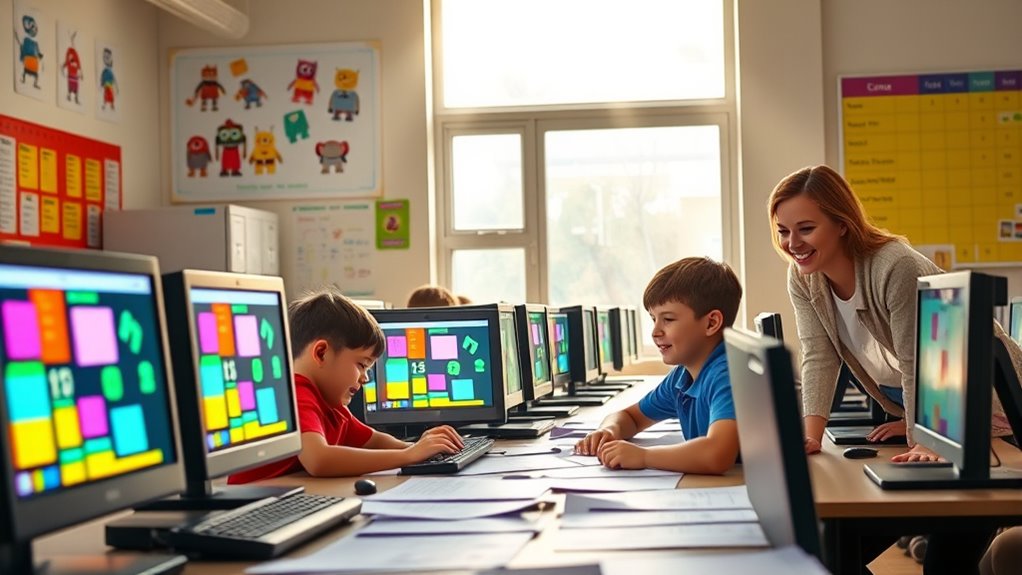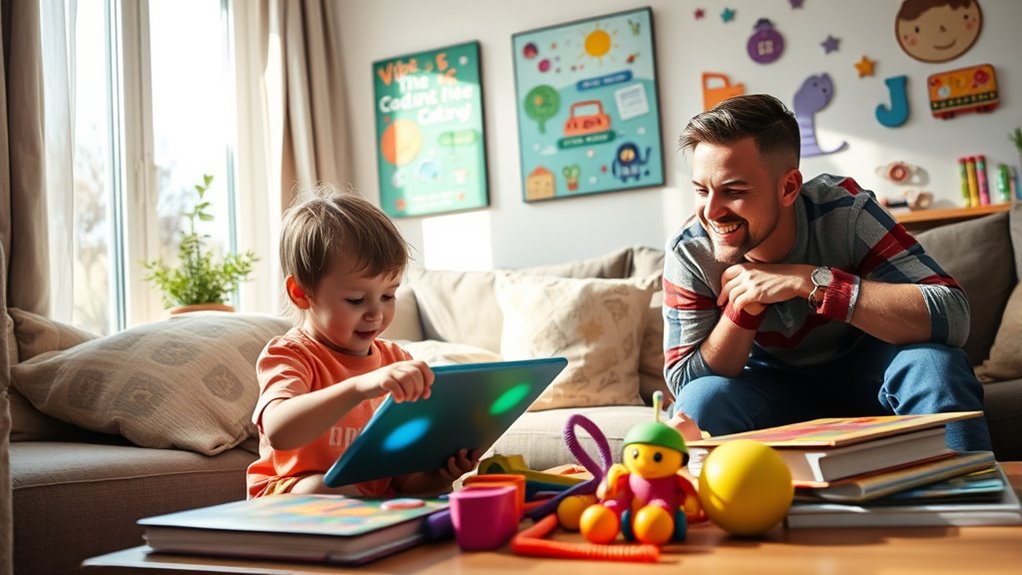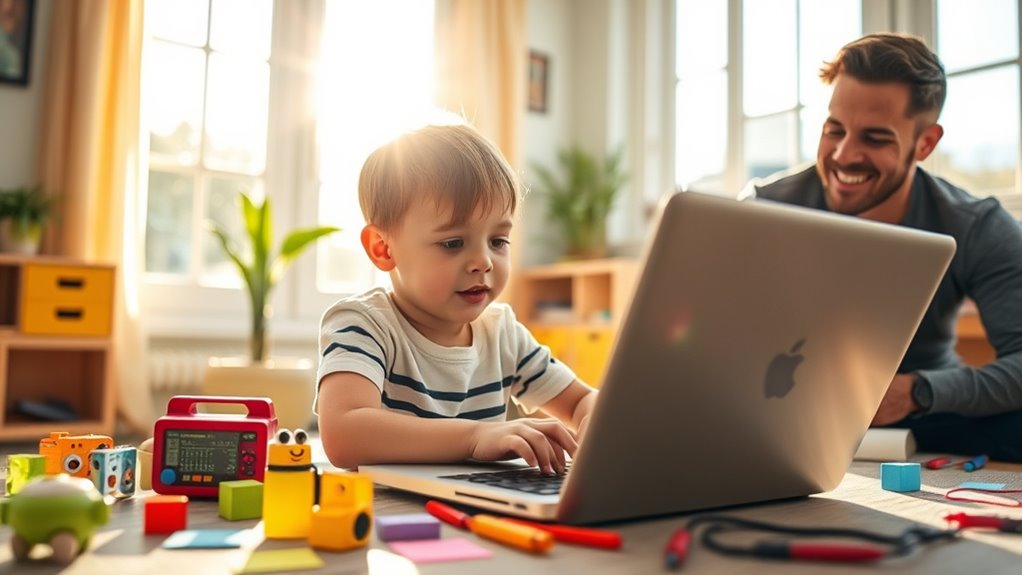Vibe coding is definitely suitable for kids. It allows them to use natural language instead of complicated syntax, making programming more accessible and fun. This approach not only enhances their understanding of technology but also fosters critical thinking and creativity. While there are some challenges, like hidden bugs and over-reliance on AI, parents can play a key role in guiding their kids. Learn how you can support your child in this exciting journey and explore more benefits.
Key Takeaways
- Vibe coding simplifies programming by using natural language, making it accessible and engaging for children.
- It enhances critical thinking, problem-solving skills, and technological literacy in kids.
- Parents should monitor AI-generated code to address potential bugs and cybersecurity risks.
- Encouraging exploration and creativity in coding fosters curiosity and prepares children for future careers.
- Providing educational resources and support helps children grasp programming principles while using AI tools.
Understanding Vibe Coding

Vibe coding is revolutionizing the way we think about programming, making it more accessible and efficient. Instead of diving deep into complex code, you can instruct AI systems using natural language. This means you focus on what your software should do while the AI handles the nitty-gritty of implementing it.
Originating from Andrej Karpathy in 2023, vibe coding emphasizes high-level descriptions over traditional coding methods. Tools like OpenAI’s Codex and GitHub Copilot play an essential role by transforming your verbal prompts into functional code snippets. Natural Language Processing is a key component in this process, enabling smoother interactions between users and AI.
You engage in a collaborative process with AI, testing through execution rather than inspection. This shift not only streamlines development but also encourages creativity, allowing you to explore programming in a whole new way. Vibe coding increases accessibility to software creation for non-programmers, making it an attractive option for kids interested in technology.
Benefits of Vibe Coding for Children

Kids can reap numerous benefits from vibe coding, making it an exciting avenue for learning programming. This approach lowers the entry barrier, allowing them to create software without needing extensive knowledge. With the help of AI, children can quickly grasp programming concepts, enhancing their creativity and technological literacy. Vibe coding fosters collaborative learning and helps develop critical thinking and problem-solving skills. It reduces stress by focusing on core concepts rather than complex syntax, boosting motivation and confidence. Additionally, vibe coding prepares kids for future careers in AI and automation while encouraging curiosity and resilience. This innovative technique represents a new approach to building software that emphasizes collaboration between humans and AI.
Challenges to Consider

While vibe coding offers exciting opportunities for young learners, it also presents several challenges that deserve careful consideration.
One major issue is the lack of human oversight, which can lead to hidden bugs in AI-generated code. Additionally, cybersecurity risks arise as these tools may not fully grasp security nuances, creating vulnerabilities. Children may struggle to debug or modify code without a solid coding foundation, and over-reliance on AI can stunt their essential coding skill development. Furthermore, vibe coding often focuses on results rather than understanding code mechanics, making it harder for kids to grasp programming principles. Finally, without adequate feedback mechanisms, they may miss valuable learning opportunities that deepen their understanding of coding. To build a solid foundation for their future, it’s essential that children engage in experiences that promote play-based learning alongside vibe coding.
The Role of Parents in Vibe Coding

As children explore the world of vibe coding, parents play an essential role in guiding their journey. You can spark their curiosity by introducing AI tools and encouraging exploration, which builds confidence in using technology. Foster creativity by allowing them to automate routine tasks, freeing them to innovate in their projects. Providing educational materials and supporting coding camps can enhance their understanding of the importance of maintaining an updated project plan and coding basics. Additionally, engaging them in activities that incorporate music therapy can promote emotional well-being and creativity. Regularly demonstrating strong communication skills can help them articulate their ideas effectively, promoting collaboration and innovation. Encouraging them to explore foods rich in omega-3 fatty acids can support their cognitive function and enhance their coding skills. Participating in spiritual retreats can also provide a calming environment that fosters creativity and mental clarity. Monitor their progress through regular feedback sessions, helping them refine their skills while ensuring they don’t become overly reliant on AI. Teaching them about solar panel orientation can provide insights into the importance of maximizing efficiency and resource management. Finally, teach ethical coding practices, discussing privacy and security issues to promote responsible use of technology. Your involvement creates a supportive environment for their coding adventure.
How to Get Started With Vibe Coding

Getting started with vibe coding opens up a world of creativity and innovation for young learners. This AI-driven approach makes coding more intuitive and accessible.
Begin by setting up an AI-powered tool like Windsurf, which lets you communicate with an AI assistant to generate code. Encourage your child to craft clear prompts that balance specificity and freedom for the AI. This iterative process helps refine their projects. Clear specifications are essential for guiding the AI effectively. Additionally, incorporating essential nutrients into their learning routines can boost cognitive function and creativity.
As they engage in this process, remind them that adopting a growth mindset will enhance their ability to embrace challenges and learn from feedback. With features like voice input, kids can experiment quickly, though they may need to practice precision. Tap into community resources for support and learning.
Vibe coding not only enhances coding skills but also fosters problem-solving and critical thinking, making it an exciting educational opportunity for your child.
The Future of Vibe Coding in Education

The future of vibe coding in education promises to reshape how students engage with technology, making software development more intuitive and accessible. As AI-assisted development techniques gain traction, traditional curricula are adapting to emphasize skills like prompt engineering and high-level system design. Schools are integrating AI coding assistants, teaching students to communicate effectively with these tools, which allows non-developers to create functional applications without deep coding knowledge. This shift comes at a time when AI-human hybrid chatbots are gaining popularity, providing additional support for students’ learning and mental health. Critics worry this might diminish fundamental coding skills, but proponents argue it fosters versatile and creative technologists. The focus on interdisciplinary skills—combining programming with ethics and psychology—prepares students for a future where AI handles repetitive tasks, freeing them to concentrate on creativity and complex problem-solving. Moreover, the integration of data analytics in education can enhance personalized learning experiences, allowing students to progress at their own pace. Furthermore, the increased accessibility of machine learning tools democratizes the use of technology, enabling more students to participate in innovative coding projects. This evolution in education not only cultivates character-driven narratives but also encourages students to express their creativity through technology. As such, the emphasis on personal development in conjunction with coding skills will empower students to grow holistically and adapt to future challenges. Additionally, the rise of AI-powered virtual reality in e-learning creates immersive environments that further enhance student engagement and understanding.
Frequently Asked Questions
What Age Is Appropriate for Children to Start Vibe Coding?
The appropriate age for children to start vibe coding varies, but it generally begins around age six. At this age, kids can engage with basic coding concepts through fun, interactive platforms.
As they grow, ages nine to twelve are ideal for deeper learning, introducing more complex ideas. By the time they reach thirteen, they can explore project-based coding, enhancing creativity and critical thinking.
Each stage builds a strong foundation for future coding skills.
Are There Specific Tools Recommended for Kids to Use in Vibe Coding?
If you’re exploring vibe coding tools for kids, consider platforms like Replit and Cursor Composer.
Replit lets kids describe their app ideas in natural language, while Cursor Composer assists with coding tasks in integrated environments.
Sonnet is another great option for generating code based on user prompts.
These tools make coding accessible and fun, allowing kids to focus on creativity and problem-solving rather than getting bogged down by complex syntax.
How Can Vibe Coding Enhance Teamwork Skills Among Children?
Vibe coding can markedly enhance teamwork skills among kids by fostering collaboration on creative projects.
When you engage your children in group coding tasks, they learn to share ideas, provide feedback, and iterate on designs together. This process encourages innovative thinking and helps them develop effective communication skills.
As they tackle challenges collectively, they’ll also gain adaptability and appreciate diverse perspectives, all of which are essential for successful teamwork in any environment.
Can Vibe Coding Be Used Offline, or Is Internet Access Required?
Can you imagine coding without the internet? Unfortunately, Vibe Coding needs online access to function properly.
Most of its AI-driven tools rely on cloud services, meaning you can’t create apps or access features like real-time feedback without connectivity.
While you can plan or learn coding principles offline, the full experience and capabilities of Vibe Coding require an internet connection to operate effectively and utilize all its resources.
What Are Some Examples of Projects Kids Can Create With Vibe Coding?
With vibe coding, you can create some exciting projects!
Think about designing animated stories with interactive characters or developing simple games that respond to user input.
You might build websites or landing pages using AI tools, or even create applications that generate images based on your prompts.
Plus, why not try your hand at making interactive animations that react to voice commands?
The possibilities are endless, and it’s a fun way to learn!
Conclusion
To sum up, vibe coding offers an engaging way for kids to explore technology and creativity. With 65% of today’s jobs requiring some level of coding skills, introducing your child to vibe coding could set them on a path to success. By fostering a fun and supportive environment, you can help them develop problem-solving skills and confidence. Embrace this innovative approach, and watch as your child discovers the joy of coding while expressing their unique vibe.









